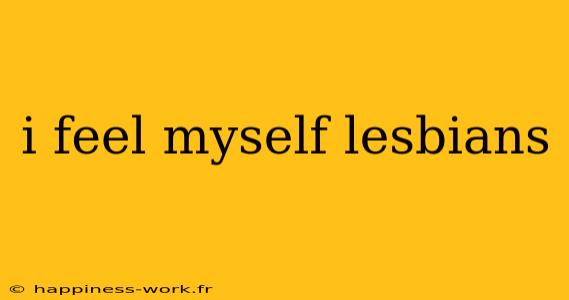In recent years, the conversation around sexual orientation and identity has become increasingly open and accepting. If you're finding yourself feeling attracted to women and identifying as a lesbian, you're not alone. Many individuals experience a range of emotions and thoughts when they begin to understand their sexual orientation. This article will explore what it means to identify as a lesbian, how to navigate these feelings, and how to embrace your identity.
What Does It Mean to Identify as a Lesbian?
Identifying as a lesbian generally means that you are emotionally, romantically, and physically attracted to women. This can encompass a wide range of experiences and feelings. Some individuals may have known their identity from a young age, while others may come to this realization later in life. It's essential to remember that everyone's journey is unique.
How Can I Know If I’m a Lesbian?
If you find yourself wondering about your sexual orientation, consider the following:
- Attraction: Do you feel drawn to women emotionally or physically?
- Experiences: Have you had romantic feelings or relationships with women in the past?
- Comfort: Do you feel more at ease and authentic when thinking about relationships with women?
These questions can help guide your understanding of your feelings. Remember, it’s perfectly normal to question your identity and take your time in exploring it.
Navigating Your Feelings
Once you identify as a lesbian or feel drawn to women, you may experience a mix of excitement and anxiety. Here are some steps you can take to navigate these feelings:
1. Educate Yourself
Understanding the LGBTQ+ community can provide comfort and clarity. Reading books, watching films, and following LGBTQ+ advocates on social media can broaden your perspective and help you feel more connected to others who share your experiences.
2. Connect with Others
Finding a supportive community can be incredibly beneficial. Consider joining LGBTQ+ groups, online forums, or social media communities where you can discuss your feelings and experiences with others. This can help you build a support network and foster connections with individuals who understand your journey.
3. Talk About It
Open conversations with trusted friends or family members can help you process your feelings. If you're not ready to come out completely, consider sharing your thoughts with a close friend who you believe will be supportive.
4. Be Patient with Yourself
Understanding your sexual orientation is a personal journey, and it’s okay to take your time. Give yourself the grace to explore your feelings without pressure.
Practical Examples and Insights
Imagine you’ve always had crushes on your female friends. Reflecting on your past relationships might reveal that you felt a stronger connection with women than men. Perhaps you find comfort in discussing your feelings and sharing experiences with a close friend who identifies as a lesbian. This could help you feel more affirmed and understood, ultimately guiding you to accept your identity.
Additional Resources
Here are some valuable resources that can aid in your journey of understanding your sexual orientation:
- Books: Consider reading “The Well of Loneliness” by Radclyffe Hall or “Stone Butch Blues” by Leslie Feinberg.
- Online Communities: Websites like The Trevor Project or LGBTQ+ Subreddits on Reddit provide resources and support for those exploring their identity.
- Counseling: Speaking with a therapist who specializes in LGBTQ+ issues can provide professional support and guidance.
Conclusion
Understanding and embracing your identity as a lesbian can be a fulfilling and empowering experience. Take your time to explore your feelings, educate yourself, connect with others, and most importantly, be kind to yourself during this journey. Remember, your identity is a beautiful part of who you are, and embracing it fully can lead to greater happiness and fulfillment.
This article is a synthesis of insights and practices for exploring sexual identity, inspired by various resources, including WikiHow articles on the topic.
